
 |
 |
 |
 |
 |
 |
 |
email: roadarch@outlook.com |
 |
| New York City Art Deco & Streamline Moderne Buildings |
(hit "refresh" to get the most recent version of this page; click on photos for larger images)
| Central Public Library Brooklyn, NY |
|
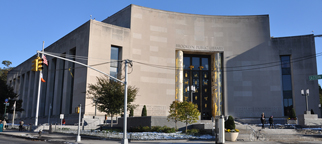 |
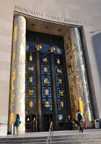 |
| The Central Public Library of Brooklyn was built in 1941. It mixes Beaux Art style with Streamline Moderne. The 40-foot-tall entrance pylons feature gold-leaf relief carvings depicting the evolution of art and science. The figures include Athena, Zeus, a miner, and an electrician. [map] |
| Sears & Roebuck & Co. Brooklyn, NY |
||
 |
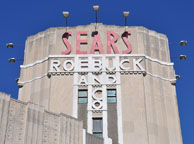 |
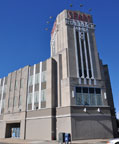 |
| This Sears Roebuck & Co. store was designed by designed by the Chicago architects Nimmons, Carr & Wright. It opened in 1932. It closed in 2021. For more, see this website. [map] |
| Williamsburgh Savings Bank Brooklyn, NY |
Ridgewood Savings Bank Queens, NY |
||||
 |
 |
 |
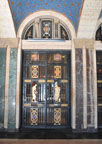 |
 |
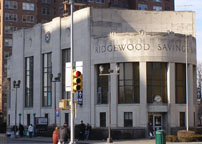 |
|
The Williamsburgh Savings Bank, aka "Wizz-be," was built in 1929 and is an example of Byzantine-influenced Art Deco. It remains Brooklyn's tallest office building. The four clock faces are each 27 feet in diameter and are sometimes out of synch. High winds can affect the movement of the huge hands. The small dome on top of the spire is a tribute to the main bank which was built in 1875. The building's interior features a 63-foot-tall ceiling and original, lush Art Deco detail. It remained a bank until 2006 with the upper floors predominantly occupied by dentists. The building has now been converted into luxury condos. The ground floor banking hall is now used for special events. For more, see this website. [map]
The Ridgewood Savings Bank was designed by Halsey, McCormick & Helmer and built from 1939-1940. [map] |
| Ambassador Hotel Staten Island, NY |
29 Broadway New York, NY |
|||
 |
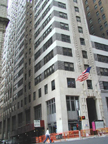 |
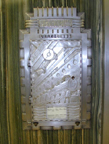 |
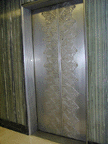 |
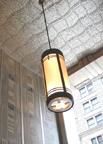 |
|
The Ambassador Hotel was built in 1932. The building is now used for apartments. [map]
29 Broadway was designed by Sloan & Robertson who were responsible for many other Art Deco buildings in New York City, including the Chanin Building, the Graybar Building, and the Majestic. It was completed in 1931 and continues to be used as an office building. [map] |
| City Bank Farmers Trust Building New York, NY |
||
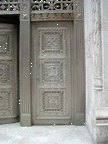 |
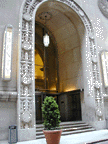 |
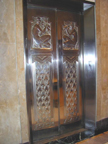 |
| When construction begin in 1929, the City Bank Farmers Trust aimed to be the tallest building in lower Manhattan. But the Depression left it conservatively stunted when it was finished in 1931. The interior and exterior are laden with Art Deco detail. [map] |
| American International Building New York, NY |
Federal Office Building New York, NY |
||
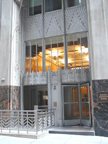 |
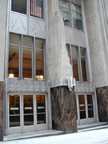 |
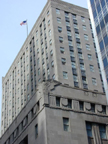 |
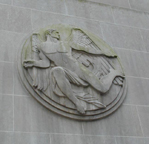 |
|
The American International Building, aka the Cities Service Building, was built between 1930-1932. It was the tallest building downtown until the World Trade Center was built. After September 11th and before the new World Trade Center was built, this was the tallest building in the Financial District and the third tallest building in New York City. One of its best features is the model of itself just outside the Pine Street entrance. [map]
The Federal Office Building was built in 1935. The limestone building contains one million square feet of office space. According to the AIA Guide, the designers had trouble deciding between stripped-down Neo-Classical and Art Deco. The building was completely renovated in the late 1990s. The building stands next door to the former World Trade Center. After September 11th, the building underwent repairs and extensive cleaning and is gradually reopening. Because of asbestos and other harmful dusts, all the interior walls had to be demolished and rebuilt. For more, see this website. [map] |
| Daily News Building New York, NY |
McGraw-Hill Building New York, NY |
||
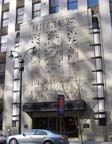 |
 |
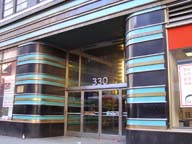 |
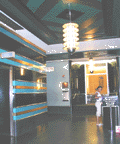 |
|
The Daily News Building was designed by Raymond Hood and built from 1929-1930. The building was the model for Superman's Daily Planet. The lobby features a giant revolving globe. The Daily News moved out of this building in 1995. [map]
The McGraw-Hill Building was built in 1931. It was designed by Raymond Hood and is an example of the Streamline Moderne International Style. Its radical blue/green terracotta cladding earned it the nickname "The Jolly Green Giant". In the early 1970s, McGraw-Hill moved and the building's fate was uncertain. However, the building returned to solvency in the mid-1970s. The remarkable interior was demolished in 2021. For more, see this website. [map] |
| American Standard Building New York, NY |
Waldorf-Astoria New York, NY |
|
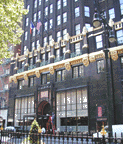 |
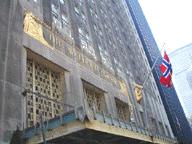 |
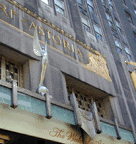 |
|
The American Standard Building is another Raymond Hood design. This one was built in 1924 for the American Radiator Co. The base of the building is clad in bronze and black granite, while the lobby is decorated with black marble and mirrors. The building now goes by the name of the Bryant Park Hotel which has been there since 2001. For more, see these websites: 1 and 2. [map]
The Waldorf-Astoria opened in 1931 and was the largest hotel in the world with over two thousand rooms. Its three-story ballroom was also the largest in the world. In the 1960s, management decided to go with an older Edwardian look and replaced much of the interior. The building was completely restored in 1982 at which time many hidden Art Deco details were discovered. [map] |
| General Electric Building New York, NY |
|||
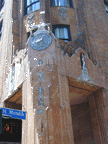 |
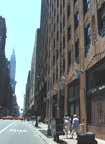 |
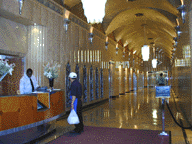 |
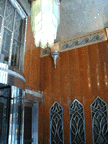 |
| The General Electric Building was designed by Cross & Cross and built between 1929-31. The design was developed to complement its next-door neighbor, St. Bartholomew's Church, yet still exhibits lots of flashy art deco detail and color. The building was originally the RCA Building until Rockefeller Center was built and GE took over. The building is now part of Columbia University. [map] |
| Lenox Lounge [gone] New York, NY |
Sofia Brothers Warehouse New York, NY |
|
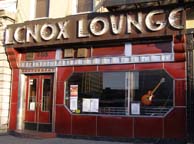 |
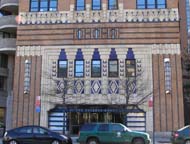 |
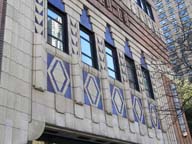 |
|
The Lenox Lounge opened in Harlem in 1939 as the Lenox Bar-B-Q. The facade is from then. The neon sign was added around 1955 when the restaurant became a jazz club. In 2013, the owner decided to relocate the bar. The letters and paneling were removed from the front of the building. They may be installed at another location which was planned to open nearby. In 2017, the original building was demolished. The letters and paneling have not reappeared. For more, see these websites: 1, 2, and 3.
The Sofia Brothers Warehouse was originally built in 1930 as a parking garage. In 1943, it was converted into a storage warehouse. The building is now used as office space for College Board. [map] |
| Lescaze House New York, NY |
Asphalt Plant New York, NY |
Brill Building New York, NY |
 |
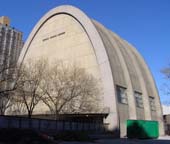 |
 |
|
The Lescaze House was built from 1933-1934. It was designed by William Lescaze as his residence and studio. It is considered the first "modern" house in New York City. For more, see this website. [map]
The Municipal Asphalt Plant was designed by Kahn & Jacobs and built in 1944. In 1982, it was converted into a sports center. It is now used as the Asphalt Green Sports and Arts Center. [map] The Brill Building was built in 1931. For more, see these websites: 1 and 2. [map] |
|
More New York City:
commercial building (Bronx) Samuel Gompers Industrial High School (Bronx) Van Cortlandt Stadium (Bronx) apartments (Brooklyn) apartments (Brooklyn) Cranlyn Apartments (Brooklyn) former Dime Savings Bank (Brooklyn) Versailles Apartments (Brooklyn) A.S. Beck (New York) [map] Chanin Building (New York) Chrysler Building (New York) Empire State Building (New York) Graybar Building (Grand Central Terminal) (New York) Health, Hospitals, and Sanitation Departments Building (New York) Majestic Apartments (New York) Metropolitan Life Insurance Building (New York) Pythian Temple (New York) Rockefeller Center (New York) Golden Gate Apartments (Queens) 1939-1940 New York World's Fair (Queens) Queens County Savings Bank (Queens) Organizations:
|
|
New York Art Deco (page 1) |
New York Art Deco (page 2) |
Art Deco Buildings Main Page |
| RoadsideArchitecture.com |
Copyright. All photos at this website are copyrighted and may only be used with my consent. This includes posting them at Facebook, Pinterest, blogs, other websites, personal use, etc. Tips & Updates. If you have suggestions about places that I haven't covered, historical info, or updates about places/things that have been remodeled or removed, I'd love to hear from you: roadarch@outlook.com. |